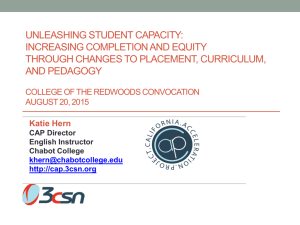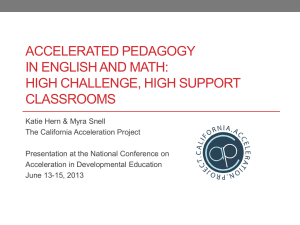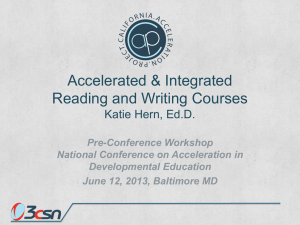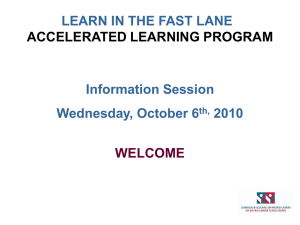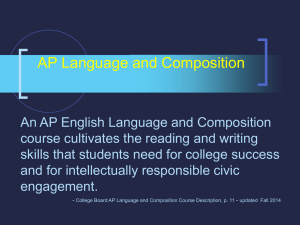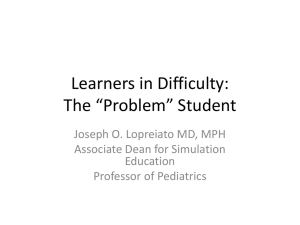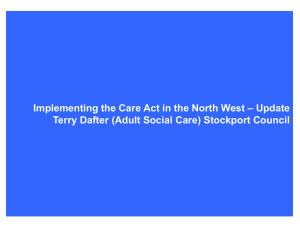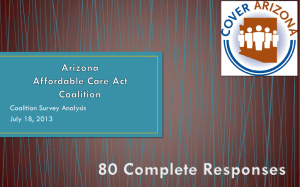Increasing Completion for Community College Students
advertisement
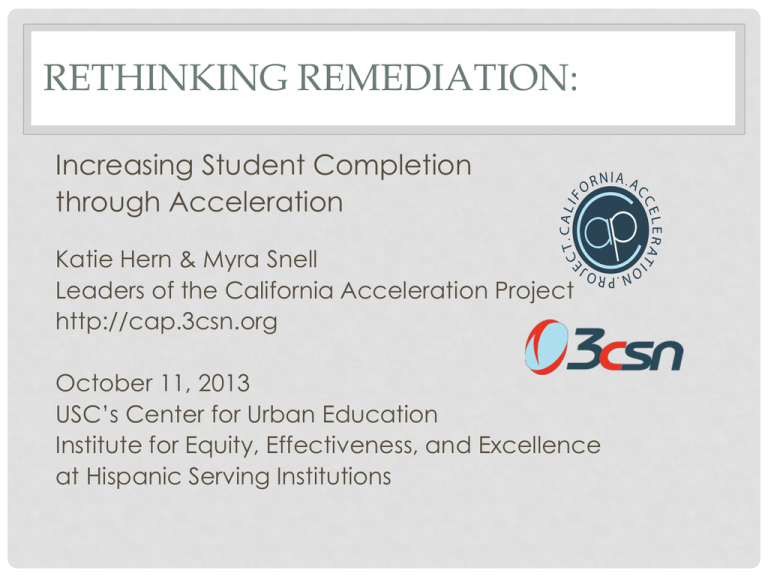
RETHINKING REMEDIATION: Increasing Student Completion through Acceleration Katie Hern & Myra Snell Leaders of the California Acceleration Project http://cap.3csn.org October 11, 2013 USC’s Center for Urban Education Institute for Equity, Effectiveness, and Excellence at Hispanic Serving Institutions SPREADING ACCELERATED REMEDIATION The California Acceleration Project supports California’s 112 community colleges to redesign their English and Math curricula to increase student completion: • Workshops and presentations to 100+ CA colleges • Professional development for faculty from 42 colleges to offer new accelerated English & math courses • CAP web resources supporting colleges to redesign remedial curricula – more than 10,000 unique hits in 18 months http://cap.3csn.org Funding provided by the state Chancellor’s Office Basic Skills Initiative, Walter S. Johnson Foundation, LearningWorks, and CCRC HIGH ATTRITION IN REMEDIATION: CALIFORNIA-WIDE DATA The lower a student begins in remedial sequences, the lower their completion of college-level courses: • Just 16% of students who begin 3 or more levels below college English complete college English in 3 years. • Just 6% of students who begin 3 or more levels below college math complete college math in 3 years. • Students of color are disproportionately placed into these lower levels. More than 50% of Black and Latino community college students are placed 3+ levels below college math. Illustration from the Basic Skills Cohort Tracker REMEDIAL ATTRITION: A STRUCTURAL PROBLEM Students placed 2 levels below college English/Math face 6 “exit points” where they fall away: • • • • • • Do they enroll in the first course? If they enroll, do they pass the first course? If they pass, do they enroll in the next course? If they enroll, do they pass the second course? If they pass, do they enroll in the college-level course? If they enroll, do they pass the college-level course? Students placed 3 levels down face 8 exit points. ILLUSTRATION: CHABOT COLLEGE Students beginning two levels below College English: • Do they enroll in the first course? ??% • If they enroll, do they pass the first course? • If they pass, do they enroll in the next course? • If they enroll, do they pass the second course? • If they pass, do they enroll in the college-level course? • If they enroll, do they pass the college-level course? (0.66)(0.93)(0.75)(0.91)(0.78)= 33% 66% 93% 75% 91% 78% Fall 2006 Cohort. Students tracked from their first developmental English enrollment and followed for all subsequent English enrollments for 3 years. Pass rates includes students passing on first or repeated attempts within timeframe. Basic Skills Cohort Tracker, DataMart. A THOUGHT EXPERIMENT… IF MORE STUDENTS PASSED THE FIRST COURSE, How many would complete college level? (0.66)(0.93)(0.75)(0.91)(0.78)= 33% If 75% passed the first course… 37% If 80% passed the first course… 40% If 90% passed the first course… 45% What if 90% passed and persisted at each point? 59% BOTTOM LINE Improving our results within the existing multi-level system will never be enough. We need to fundamentally restructure our approach to under-prepared students and eliminate the exit points where we lose them. ALTERNATIVES TO MULTI-SEMESTER REMEDIATION IN READING/WRITING Student completion of college English is significantly higher in accelerated models of remediation: • Co-requisite models enroll “remedial” students into collegelevel courses and provide additional time and support to help them succeed. • One-semester pre-requisite models provide a single welldesigned semester of preparation to students with any placement score. Shortening the remedial pathway by a semester is correlated with 20+ percentage points higher completion of college English in established models. CO-REQUISITE MODEL Community College of Baltimore County Upper-level remedial students enroll in a regular college English course, plus a small support class with the same teacher. Completion of College English CCBC Traditional remedial sequence Accelerated Learning Program 40% 75% Jenkins, D. et al (Sept. 2010). A Model for Accelerating Academic Success of Community College Remedial English Students: Is the Accelerated Learning Program (ALP) Effective and Affordable?(CCRC Working Paper No. 21). New York: Community College Research Center, Teachers College, Columbia University. ONE-SEMESTER ACCELERATED PRE-REQUISITE TO COLLEGE ENGLISH Chabot Las Positas Community College District Integrated reading and writing course open to students with any placement score below college-level; alternative to twosemester remedial sequence. Completion of College English 2-semester Accelerated remedial path course Chabot College 28%-34% 52%-57% Las Positas College 35%-48% 67%-68% 3-year completion data from the Basic Skills Cohort Tracker. Student cohorts beginning in Fall 2000, 2003, 2006, and 2008. Repeats included. http://datamart.cccco.edu/Outcomes/BasicSkills_Cohort_Tracker.aspx ACCELERATED REMEDIATION IN MATH Paradigm Shift: Math Pathways Remediation not a repeat of K-12 mathematics through Algebra II. Instead, support tailored to the student’s intended program of study or meta-major. • Intensive algebra preparation for students pursuing STEM, other calculus-based majors • Students in other majors enroll in college-level Statistics or Liberal Arts Math, with co-requisite or accelerated prerequisite support • Redesigned accelerated course replaces 2-3 semesters of traditional sequence; some models offer a single semester of developmental preparation to students with any placement score WHY PATHWAY REDESIGN: MISALIGNMENT BETWEEN ALGEBRA & STATISTICS PROMISING PRELIMINARY RESULTS FROM SOME COLLEGES Completion rate: percent of students enrolled at first census in a developmental math course that complete a transfer-level math course. Statistics Pathway (1 year) Traditional Pathway (3 years) Cuyamaca 50% (171) 23% (2315) Los Medanos 60% (119) 21%(1756) At both colleges most students enrolled in the Statistics pathway had a placement level of 2 to 3 levels below transfer-level math (65% at Cuyamaca and 73% at LMC). At both colleges the majority of students were non-Asian students of color (58% Cuyamaca, ~ 75% LMC). Third-party evaluation of the first year of implementation for 8 colleges in CAP’s first cohort due out in December. A CASE STUDY: CLOSING THE EQUITY GAP Cuyamaca Completion Rates by Ethnicity Statistics Pathway (1 year) Traditional Pathway (3 years) Black nonHispanic 42% (24) 10% (185) HIspanic 45% (60) 22%(630) Two or More 73% (11) 29% (93) White nonHispanic 52%(68) 26%(1028) CAP Principles for Curricular Redesign • Increasing completion of college-level English and Math requires shorter developmental pathways and broader access to college-level courses. • We must reduce our reliance on high-stakes placement tests, which are poor predictors of student capacity. • Streamlined developmental curricula should reflect five key principles: – – – – – Backward design from college-level courses Relevant, thinking-oriented curriculum Just-in-time remediation Low-stakes, collaborative practice Intentional support for students’ affective needs Reading/Writing Away from… Traditional remediation front-loads sub-skills, on the assumption that before students can do a more complex task, they must have mastery of its component parts: • In reading: workbook exercises on recognizing main ideas, building vocabulary • In writing: grammar exercises before paragraph writing, personal essays before text-based essays Toward… In English, accelerated pedagogy gives under-prepared students experience with college-level reading, reasoning, and writing, with more in-class scaffolding and support than in a regular college course. Sub-skills in reading and writing are addressed as needed in the context of the more challenging work. From Deceleration to Acceleration: An Illustration Typical Changes to Pedagogy • More reading assigned, more challenging texts • More class time spent discussing and writing about readings, less on grammar instruction • Readings used not just as “models” of writing, but as content for students’ own papers • Writing assignments not simply about personal experience – students write academic essays; paraphrase, quote, synthesize texts; and use critical thinking to answer higher-order questions Insights from CAP faculty “In the non-accelerated classroom, I think I focused more on teaching students to eliminate the superficial errors, so students in that class ended up producing a ‘prettier’ assignment; however, their writing did not illustrate complexity of thought….This was partly due to the formulaic nature of the assignments I used to give (topic sentence should look like this and be placed here, supporting details should go here, etc.) and mostly due to the lack of opportunity for critical thinking in my previous assignments.” Summer Serpas, Irvine Valley College Insights from CAP faculty “With the right support, students are capable of doing great academic work! They don’t need to start with a simple paragraph. They can write complex essays from the start.” -Anonymous faculty reflection “Teaching accelerated courses has changed my outlook on student capacity. I learned to trust in students’ ability to handle challenges and tackle meaningful academic work. - Caroline Minkowski, City College SF Window into the Classroom • Video footage from Myra Snell’s pre-statistics course, Fall 2009 • Los Medanos students grapple with a problem from the national statistics exam, CAOS • Video filmed and edited by Jose Reynoso, a student coinquirer working with Snell through a grant from the Faculty Inquiry Network http://vimeo.com/9055488 (or go to Vimeo and search for “Statpath”) Math Pedagogy • Away from…decontextualized algebra, mimicry of symbolic procedures and template word problems An apple falling from a tree is h feet above the ground t seconds after it begins to fall, where h=64-16t^2. How long does it take the apple to hit the ground? • Toward… data analysis and decision-making in the face of uncertainty What factors correlate with low birth weights? Use graphs and conditional percentages to investigate the relationship between one of the factors in the data set and low birth weight. Present your results in 500 words or less, include relevant graphs and calculations. Data set: Birth weights and 6 qualitative factors from a Massachusetts study of 189 pregnant women. Changes to Math Pedagogy: An Illustration Student Reflections “It was developing my critical thinking. Not just looking at a formula and learning how to solve it – you know, where does this go, what are the rules….It’s more about evaluating, it’s more about the analysis…It’s more about understanding how to make a conclusion about the data set.” Describing her instructor’s approach to the class: “It’s kind of like…You dig in and get your hands dirty, however you feel you need to, and I’m here for you to help clarify, to help understand, help get you along better. I like that. It’s more like the instructor is a facilitator, as opposed to, I’m spewing out all this information that I need you to regurgitate on an exam.” -Accelerated Pre-Statistics Students at College of the Canyons Faculty Reflections “I go to the board, and I start to lecture, and it kills the magic in the room….They’re not enthusiastic, they’re not paying attention, they’re looking at their cell phones….I figure, If I just explain at bit more, it’ll be ok. But the more I tried to front-load, the worse it got. And then this kid in the class comes up after….and he goes, ‘Now Terrie, I’ve noticed that your pedagogical practices have been about us discovering what we need, and I think what happened today is that you failed to trust the process.’” -Terrie Nichols, Math Instructor, Cuyamaca “I kind of started getting into this mindset, Well, if they don’t care, I can’t make them care…I really just thought it was laziness. Now I realize…it’s just that students are intimidated. They don’t want to act like they care because then they would be failures if they didn’t succeed.” -Evelyn Ngo, Math Instructor, College of the Canyons Intentional Support for Students’ Affective Needs Student fears and fixed mindsets are two of the biggest challenges to overcome in highchallenge accelerated classes. – The College Fear Factor by Rebecca Cox Many community college students fear that they’re not cut out for college and cope with this fear by withdrawing and/or “avoiding assessment” (e.g., not take tests, not turn in papers) – “Brainology” by Carol Dweck Whether students have a “fixed” or “growth” mindset about their own intelligence strongly influences their academic performance, especially their response to challenging tasks The California Acceleration Project: Using a Cost Efficiency Model to Investigate Key Outcomes and Fiscal Considerations Dr. Rob Johnstone Strengthening Student Success Conference Burlingame, CA October 10, 2013 www.inquiry2improvement.com 30 Summary of Findings When the model was applied to real-world data from the seven initial CAP colleges, we found that: CAP significantly increases student completion of transferable math courses CAP significantly lowers cost per completer CAP reduces the cost of remediation and allows dollars to be reallocated to transferable courses CAP results in a significant decrease in student tuition / books costs and an increase in wage gains by helping students complete sooner National Center for Inquiry & Improvement www.inquiry2improvement.com 31 College-based Outcomes, Cuyamaca College Outcome Traditional CAP Improvement 22% 50% 127% 2. Total cost of Pathway, Including Transfer Course $264,766 $289,796 -9% 3. Cost of Pre-Transfer Math Courses in Pathway $193,710 $149,426 23% $1,934 $831 57% 73% 52% 30% 1. Blended Entering Cohort Completion Rate of Transfer-Level Math Course 4. Cost per Completer of Transfer-Level Math Course 5. Percentage of Cost in Pre-Transfer Math Courses National Center for Inquiry & Improvement www.inquiry2improvement.com Join us! • One-day regional workshops: – November 15, Clovis Center (Central Valley) – February 7, Chabot College (Bay Area) – March 7, West LA College (Greater LA) • More information on all of today’s session will be available through the CAP website in the coming months: http://cap.3csn.org khern@chabotcollege.edu, msnell@losmedanos.edu
